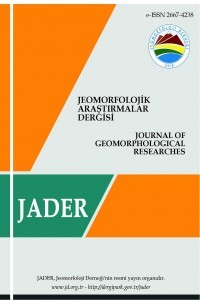
Jeomorfolojik Araştırmalar Dergisi
Yazarlar: Ali UZUN, Faruk AYLAR, Serkan GÜRGÖZE
Konular:Fiziki Coğrafya
DOI:10.46453/jader.778432
Anahtar Kelimeler:Karst Jeomorfolojisi,Mağara,Speleoloji,Hayat Mağarası,Samsun,Türkiye
Özet: In this study, Hayat Cave karst system was investigated. The research area is included within the borders of Başaran village of Bafra district in Samsun province. The system has original shapes belonging to surface and depth karst. The aim of the study is to investigate the ecological, morphological and speleological features of the Hayat Cave karst system which has not been a subject of any scientific research up to now. The study is mainly based on area observations and measurements. The knowledge obtained from the area and literature was processed in Geographical Information Systems and they were converted into visual materials. The region has a humid and temperate climate suitable for karstification. The bedrock is generally composed of volcano-sedimentary rocks. However, limestones suitable for karstification are encountered in some places as well as around of Basaran village. Brown forest soils are widespread in the area. Flat and slightly sloping lands were generally opened to agriculture in the region. In sloping areas, wide-leaved forests consisting of species such as beech, hornbeam, chestnut and oak dominate the view. In the area, there are wolf, fox, jackal, marten, hedgehog, squirrel and roe deer as wild animals. Flies, spiders and bats can be seen in the caves. Hayat Cave karst system starts with a fluviokarstic depression which is in the east of Başaran village. Kavaklıgöl Creek which drains the water of the system goes into underground from the sinkholes at the north end of depression. The stream has respectively created two caves while flowing into underground. The Başaran Cave above is dry whereas the Hayat Cave below is active. The stream falls into the Hayat Cave and flows 35 m in the main gallery, and then sinking from a sinkhole and disappears. The entrance side of the cave is dry because of this. However, the mud levels, the pebbles and blocks in the bed show that the stream empties from the mouth of the cave into the valley during the floods. Inside the caves there are speleothems with high visual appeal. If the caves are opened to tourism, they can contribute to the development and diversification of local tourism.